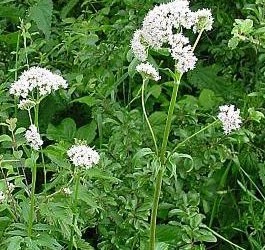|
Gardens Ablaze |
||
|
|
Valerian
|
|
|
Additional Valerian Information
Medicinal Uses Site Map
Home |
Valerian obviously has no culinary uses because of the smell. However, it is a major player in the herbal medicine cabinet as a sedative, anti-depressant, and tranquilizer, and has been used for over 1,000 years for these purposes. In America, we have not tested these properties adequately, but in other parts of the world, Valerian is a standard for stress, sleep, and relaxation purposes. Please see the Medicinal Uses page for more information. Valerian is an easy to grow plant but requires fertile, weed-free soil. It is a heavy nitrogen-feeder, so fertilize accordingly. If growing as a medicinal herb, cut flower stalks as soon as they appear to direct more energy to the root, but if growing as an ornamental, let the plant flower, as the flowers have a sweet, cherry pie fragrance, a trademark of the Heliotrope family. Propagate Valerian by runner or crown division in spring or fall. Small daughter plants can also be harvested at the end of summer. Transplant to at least a foot apart, as these plants grow up to 5 feet tall and a foot wide at maturity. Valerian can also be propagated by seed, but germination rate is poor. The seedlings are frost hardy, however, so take advantage of early spring rains if you want to try sowing directly into the garden by seed. Given the right conditions, Valerian will self-sow with little attention, but overcrowding will make for a sorry show, so do dig and renew by division every three years or so. Valerian roots can be harvested in the spring or fall. Wash, then quickly dry at 120 degrees in the oven until brittle. Watch this closely so you don't burn the roots. When stored in an airtight container, the roots will keep indefinitely.
Custom Search
|
|
|
Gardens Ablaze |
||
 Valerian,
or garden Heliotrope, is an member of a species of about 200 plants.
Valeriana Officinalis, which we will deal with here, is an attractive perennial
with merits in both the ornamental and medicinal herb garden. Unfortunately,
the whole plant, with the exception of the flower, has a putrid, rotted
cheese.....smelly sock odor. In fact, the smell is bad enough for
the early Greeks to have named it Phu (Phew!). But offensive smells
are apparently individualistic, because if your cat finds this plant, they
will worry it to death because they LOVE the smell. Once they find
it, they will stomp, roll, and frisk around the plant until it gives up
the ghost. They apparently find the smell of dirty socks intoxicating,
so if you are the crafty type and want to please your feline, make an herbal
pillow out of Valerian, and your cat will provide you with hours of entertainment!
Conversely, Valerian also attracts rats, and some people plant it on the
borders of their property to lure the rats away from the home.
Valerian,
or garden Heliotrope, is an member of a species of about 200 plants.
Valeriana Officinalis, which we will deal with here, is an attractive perennial
with merits in both the ornamental and medicinal herb garden. Unfortunately,
the whole plant, with the exception of the flower, has a putrid, rotted
cheese.....smelly sock odor. In fact, the smell is bad enough for
the early Greeks to have named it Phu (Phew!). But offensive smells
are apparently individualistic, because if your cat finds this plant, they
will worry it to death because they LOVE the smell. Once they find
it, they will stomp, roll, and frisk around the plant until it gives up
the ghost. They apparently find the smell of dirty socks intoxicating,
so if you are the crafty type and want to please your feline, make an herbal
pillow out of Valerian, and your cat will provide you with hours of entertainment!
Conversely, Valerian also attracts rats, and some people plant it on the
borders of their property to lure the rats away from the home.